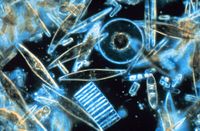
Photo from wikipedia
Diatoms stand out among other microalgae due to the high diversity of species-specific silica frustules whose components (valves and girdle bands) are formed within the cell in special organelles called… Click to show full abstract
Diatoms stand out among other microalgae due to the high diversity of species-specific silica frustules whose components (valves and girdle bands) are formed within the cell in special organelles called silica deposition vesicles (SDVs). Research on cell structure and morphogenesis of frustule elements in diatoms of different taxonomic groups has been carried out since the 1950s but is still relevant today. Here, cytological features and valve morphogenesis in the freshwater raphid pennate diatom Encyonema ventricosum (Agardh) Grunow have been studied using light and transmission electron microscopy of cleaned frustules and ultrathin sections of cells, and scanning electron and atomic force microscopy of the frustule surface. Data have been obtained on chloroplast structure: the pyrenoid is spherical, penetrated by a lamella (a stack of two thylakoids); the girdle lamella consists of several short lamellae. The basic stages of frustule morphogenesis characteristic of raphid pennate diatoms have been traced, with the presence of cytoskeletal elements near SDVs being observed throughout this process. Degradation of the plasmalemma and silicalemma is shown to take place when the newly formed valve is released into the space between sister cells. The role of vesicular transport and exocytosis in the gliding of pennate diatoms is discussed.
Journal Title: Protoplasma
Year Published: 2017
Link to full text (if available)
Share on Social Media: Sign Up to like & get
recommendations!